新版PEP版小学英语四年级下册第四单元教案
新版PEP小学英语四年级下册Un...

PEP 小学英语四年级Unit4 My homePartA Let's learn & let’s do教学设计[教学内容]词汇:study, bathroom, living room, kitchen, bedroomThis is my home. You can see….课文:(课文原文)Let’s learn:This is my home. You can see a bedroom, a living room….Let’s do:Go to the living room. Watch TV.Go to the study. Read a book.Go to the kitchen. Have a snack.Go to the bathroom. Take a shower.Go to the bedroom. Have a sleep.教学目标:知识与能力:1. 能听懂、会说:Welcome to my home!并能简单描述自己的房间。
2. 能听、说、认读study, bathroom, living room, kitchen , bedroom并能在日常生活中运用。
3. 能听懂Let’s do中的指示语,并按照指令做出相应的动作。
4. 了解西方国家的房屋结构及各部分名称。
情感与态度:1. 学生通过本课的学习,培养学生对家及家人的热爱,充分享受拥有家的幸福。
2. 通过引导学生设计自己未来的家居,培养学生的创新意识。
3. 通过小组合作学习,培养学生的合作精神。
教学重点:词汇:study, bathroom, living room, kitchen,bedroom句型:This is my home. You can see….教学难点:1、单词bathroom, bedroom, kitchen的发音2、学生能够在实际情景中介绍自己的家。
教具准备:单词卡片、彩色卡纸、房间平面图及各房间图片媒体使用:课件教学过程教学步骤:一、热身、复习(Warm-up / Revision)A. Sing a song “In my classroom”.B. Ask and answerWhat can you see in our classroom?What can you do in our classroom?【设计意图】教师和学生一起带动作的唱有关Classroom的歌曲,不仅活跃了气氛,使学生尽快地融入英语课堂学习的氛围。
PEP小学英语四年级下册第四单元教学设计
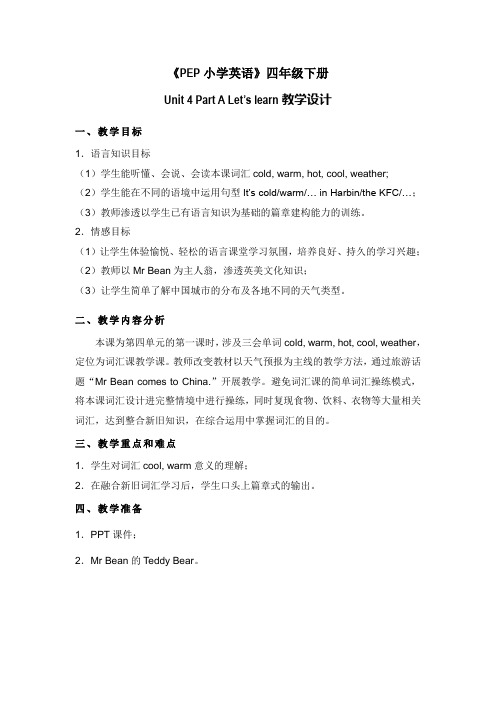
《PEP小学英语》四年级下册
Unit 4 Part A Let’s learn教学设计
一、教学目标
1.语言知识目标
(1)学生能听懂、会说、会读本课词汇cold, warm, hot, cool, weather;
(2)学生能在不同的语境中运用句型It’s cold/warm/… in Harbin/the KFC/…;(3)教师渗透以学生已有语言知识为基础的篇章建构能力的训练。
2.情感目标
(1)让学生体验愉悦、轻松的语言课堂学习氛围,培养良好、持久的学习兴趣;(2)教师以Mr Bean为主人翁,渗透英美文化知识;
(3)让学生简单了解中国城市的分布及各地不同的天气类型。
二、教学内容分析
本课为第四单元的第一课时,涉及三会单词cold, warm, hot, cool, weather,定位为词汇课教学课。
教师改变教材以天气预报为主线的教学方法,通过旅游话题“Mr Bean comes to China.”开展教学。
避免词汇课的简单词汇操练模式,将本课词汇设计进完整情境中进行操练,同时复现食物、饮料、衣物等大量相关词汇,达到整合新旧知识,在综合运用中掌握词汇的目的。
三、教学重点和难点
1.学生对词汇cool, warm意义的理解;
2.在融合新旧词汇学习后,学生口头上篇章式的输出。
四、教学准备
1.PPT课件;
2.Mr Bean的Teddy Bear。
pep人教版四年级下册英语第四单元教案含教学反思
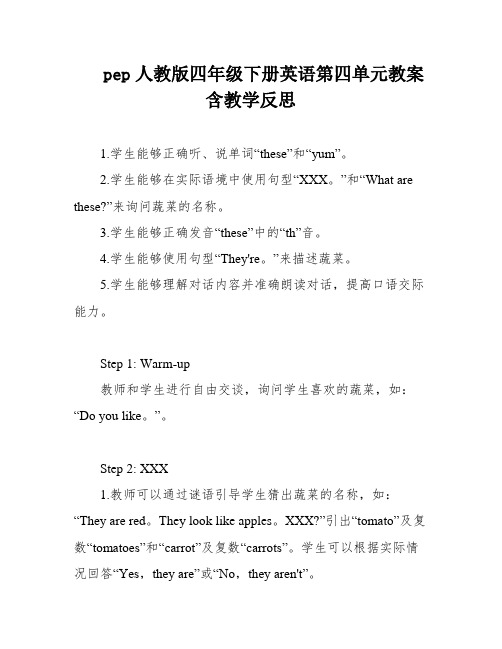
pep人教版四年级下册英语第四单元教案含教学反思1.学生能够正确听、说单词“these”和“yum”。
2.学生能够在实际语境中使用句型“XXX。
”和“What are these?”来询问蔬菜的名称。
3.学生能够正确发音“these”中的“th”音。
4.学生能够使用句型“They're。
”来描述蔬菜。
5.学生能够理解对话内容并准确朗读对话,提高口语交际能力。
Step 1: Warm-up教师和学生进行自由交谈,询问学生喜欢的蔬菜,如:“Do you like。
”。
Step 2: XXX1.教师可以通过谜语引导学生猜出蔬菜的名称,如:“They are red。
They look like apples。
XXX?”引出“tomato”及复数“tomatoes”和“carrot”及复数“carrots”。
学生可以根据实际情况回答“Yes,they are”或“No,they aren't”。
2.教师可以将装有蔬菜卡片的盒子放在桌子上,然后走到学生中间随意指着几个盒子问:“Are these。
”引导学生根据实际回答,用“Yes,they are”或“No,they aren't”。
如果回答是“No,they aren't”,教师要继续问:“What are these?”并引导学生使用“They are。
”回答。
教师可以多问一些学生,并适时在黑板上板书。
3.学生可以两人一组使用黑板上的句型互相猜猜对方盒内的蔬菜。
4.播放“Let's talk”录音,学生跟读并模仿对话,理解对话内容,掌握“these”和“yum”等单词。
5.分小组进行对话练,教师可以点拨“these”中“th”音的发音要咬舌,并让学生戴上人物头饰进行角色表演。
Step 3: n and nStep 1: Warm-upIn pairs。
XXX fruits。
while the other guesses and answers using the following sentence structures:What are these。
PEP小学英语四年级下册UNIT4整体教学设计[修改版]
![PEP小学英语四年级下册UNIT4整体教学设计[修改版]](https://img.taocdn.com/s3/m/fd5c10da453610661fd9f476.png)
第一篇:PEP小学英语四年级下册UNIT4整体教学设计pep小学英语四年级下册unit4整体教学设计北海市海城区第三小学刘珊珊一、教材内容分析我们本次整体教学设计的内容是pep小学英语四年级下册第四单元。
本单元围绕与我们生活息息相关的“天气”这一话题展开,通过学习,学生将学会用英语表达天气状况,对天气状况进行询问、预报及讨论和确定相应着装,描述各种天气情况下可开展的各类活动。
本单元和clothes , activity这两个话题紧密结合,通过用中学、学中用、反复实践、学用结合的方式,在巩固和丰富“表述天气”这一项目的同时,也促进了学生语言技能的发展。
二、单元整体教学目标1、能力目标:(1)能够简单介绍天气情况。
(2)能说出不同天气情况下该穿什么衣服和可以开展的活动。
(3)能听懂并回答一些问题,如:whats the weather like in beijing? can i wear my new jacket? (4)会规范书写句子:its warm today. lets play football. its cool. is it cold? (5)会唱歌曲thunder。
2、知识目标:(1)掌握a、b部分read and write中的四会单词和句子,并能做到会听、说、读、写。
(2)听、说、认读a、b部分lets learn 、lets talk中的单词和句子。
(3)理解lets do 、lets chant等部分的内容。
(4)了解story time、good to know等部分的内容。
3、情感目标:增强学习的愿望,合作学习,积极参与实践活动。
4、学习策略:培养学生自主学习和小组合作学习的能力。
5、文化目标:了解世界主要城市的天气差异和谈论天气所具有的寒暄功能。
三、教学重难点本单元重点学习表示天气状况的形容词。
what’s the weather like in?? it’s ?in? can i wear my?? yes, youcan. no, you can’t.是本单元的重点句型。
pep人教版四年级下册英语第四单元教案含教学反思
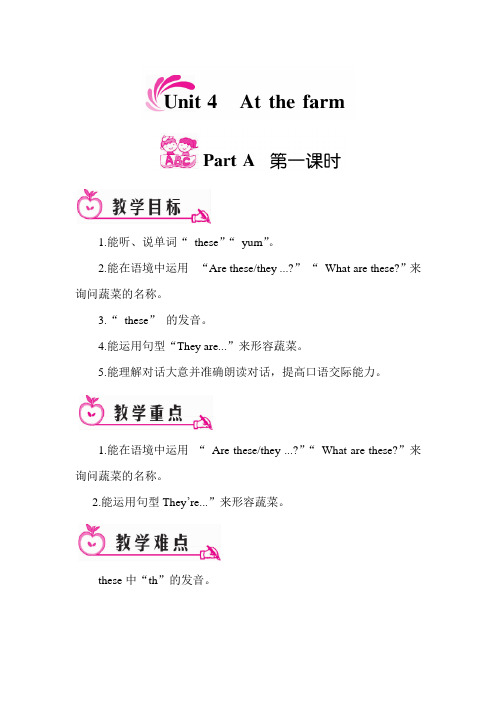
1.能听、说单词“these”“yum”。
2.能在语境中运用“Are these/they ...?”“What are these?”来询问蔬菜的名称。
3.“these”的发音。
4.能运用句型“They are...”来形容蔬菜。
5.能理解对话大意并准确朗读对话,提高口语交际能力。
1.能在语境中运用“Are these/they ...?”“What are these?”来询问蔬菜的名称。
2.能运用句型They’re...”来形容蔬菜。
these中“th”的发音。
人物头饰,教学光盘,蔬菜或水果的图片。
Step 1:Warm-up教师和学生Free talk,耳卯一助吡较喜爱的蔬菜。
如:like ...Do you like...?Step 2:Presentation①教师说谜语,引导学生用“Are they... ?”来猜猜是什么疏菜。
A :They are red. They look like apples,but they aren’t apples. What are they?B: They are long and orange. Rabbits like eating them.引出“tomato”及复数“tomatoes”和“carrot”及复数“carrots”学生在猜的过程中,如果猜对了,回答:Yes,they are.猜错了,回答No,they aren’t.②教师请学生将装有蔬菜卡片的盒子盖好放在桌子上,然后走到学生中间随意指着几个盒子问:“Are these...?”引导学生根据实际回答,用Yes,they are. .No,they aren’t.如果回答的是:No,they aren’t.教师要继续问:What are these?并引导学生用“They are ...”回答,多问一些学生,适时板书。
③学生两人一组运用黑板上的句型互相猜猜对方盒内的蔬菜。
④播放“Let’s tk”录音,学生听录音,跟读模仿,并明白对话大意,理解“these,yum”。
【PEP】四年级下英语Unit4优质课说课稿

【PEP】四年级下英语Unit 4优质课说课稿一. 教材分析本节课选自人教版小学英语PEP教材四年级下册Unit 4,主题是“Weather”。
本单元主要学习天气相关的词汇和句型,通过描述天气情况,培养学生的语言表达能力和交际能力。
教材内容丰富,插图生动有趣,符合小学生认知特点。
二. 学情分析四年级的学生已经掌握了基本的英语语音、词汇和简单的语法知识,具备一定的听说读写能力。
但在实际交际中,学生往往因为词汇量和语法知识的局限而感到困难。
因此,在教学过程中,需要注重拓展学生的词汇量,加强语法训练,提高学生的交际能力。
三. 说教学目标1.知识目标:学生能够掌握天气相关的词汇,如sunny, cloudy, rny,windy等;能够运用所学句型描述天气情况。
2.能力目标:学生能够在日常生活中运用所学知识进行 weather 的简单交流。
3.情感目标:培养学生热爱生活、关注天气的情感态度。
四. 说教学重难点1.重点:天气相关词汇的掌握和运用。
2.难点:句型We have … weather in … 的运用。
五. 说教学方法与手段本节课采用情境教学法、交际法、任务型教学法等。
通过设置天气情境,引导学生运用所学知识进行实际交际。
同时,运用多媒体教学手段,如课件、视频等,提高学生的学习兴趣和参与度。
六. 说教学过程1.热身(5分钟):通过歌曲“What’s the weather like?”引导学生唱跳,激发学习兴趣。
2.呈现(10分钟):教师展示天气图片,引导学生说出相关词汇,如sunny, cloudy等。
3.操练(10分钟):学生分组进行角色扮演,运用所学句型描述天气情况。
4.拓展(10分钟):学生观看天气预报视频,学会用英语描述天气变化。
5.总结(5分钟):教师带领学生回顾本节课所学内容,加深记忆。
七. 说板书设计板书设计采用思维导图形式,将天气词汇和句型呈现出来,便于学生理解和记忆。
八. 说教学评价本节课采用形成性评价和终结性评价相结合的方式。
PEP四年级下册unit4全英详细教案
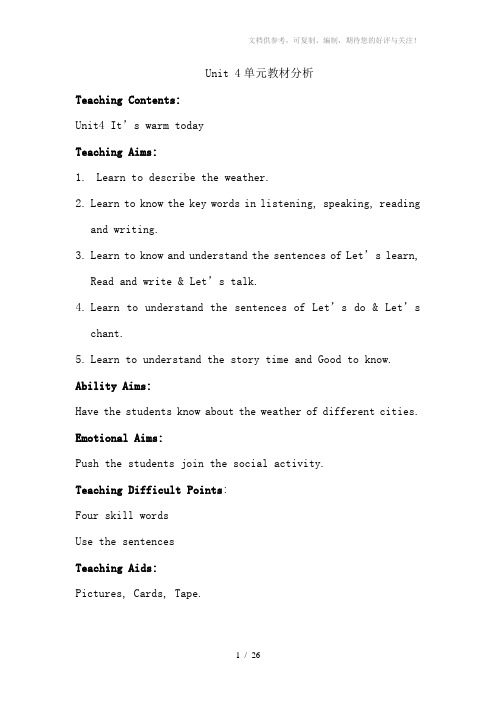
Unit 4单元教材分析Teaching Contents:Unit4 It’s warm todayTeaching Aims:1. Learn to describe the weather.2.Learn to know the key words in listening, speaking, readingand writing.3.Learn to know and understand the sentences of Let’s learn,Read and write & Let’s talk.4.Learn to understand the sentences of Let’s do & Let’schant.5.Learn to understand the story time and Good to know. Ability Aims:Have the students know about the weather of different cities. Emotional Aims:Push the students join the social activity.Teaching Difficult Points:Four skill wordsUse the sentencesTeaching Aids:Pictures, Cards, Tape.The 8th week and 1st planUnit 4 It’s warm todayThe 1st periodTeaching contents:Part A: Let’s learnLet’ playTeaching Aims:1. To act quickly after listening to the T.2. Master the sentences: This is my home. You can see a bedroom...3. New words: study bathroom bedroom living room kitchen Ability Aims:Have the students know about the weather of different cities. Emotional Aims:Push the students join the social activity.Important points and difficult points:1.Learn to understand the key words in listening, speaking andreading.2.Try to understand the word, and use them into sentences.3.Learn to understand the sentences of What’s the weatherlike in…? It’s …Teaching Aids:A tape-recorder,an English book, a Chinese book,a storybook, a notebook and a math book.Teaching Procedures:Step 1: Warm-up:1.Greetings: How are you?2.Date ,day& weather.What’s the date today?What’s the weather like today? What day is it today?T:what do you wear in hot day/cool day/cold day?S: I can wear skirt/sweater/Step 2: Revision1.The teacher asks the class:What’s your favorite clothes?What colour is your…?Pay attention to the wor d “favorite”2. A game: Guess what colour of the clothes?Step 3: PresentationLet’s learn1.The teacher will show the cards to the class one by one: cool,cold, hot, warm.2.Try to use the new words to make some sentences such as:What’s the weather like…? It’s cool/ cold / hot/ warm.Teacher can give the pictures and let the pupils talk about the weather.3.Listen to the tape, and repeat it after the tape:Good morning. This is the weather report. It’s cool in Lhasa.4.Group work: Watch the VCD first, and then practice thesentences with their group.What’s the weather like in Shanghai/Beijing…?---It’s…Step 4: Practice1.Read the passage ater the tape.2. Read the passage and translate it.3. Read the passage by groups.4. Let’s playHave the students act like the weather reporter.He/She point to the place, others have to say the weather out. Step 5: Homework:1. To copy the new words one line for each2. Ready for a weather report.Board-writing:Unit 4 It’s warm today!weather, cool, cold, hot, warm.What’s the weather like in…?I t’s …ReflectionThe 2nd periodTeaching contents:Let’s talkLet’s chantTeaching Aims:1.Learn to understand the sentences of Let’s talk.2.Learn to express the weather.3.Learn to know the “Can I wear…?” ask and answer.Ability Aims:Have the students know about the weather of different cities. Emotional Aims:Push the students join the social activity.Important points and difficult points:New words and sentencesTeaching Aids:Computer, cassette, cassette recorder, flash cards, some objects.Teaching Procedures:Step 1: Warm-up1.Let’s chantMmm! It’s warm today.Take off your jacket!Phew! It’s hot today!Put on your T-shirt.Ooooh! It’s cool today!Put on your sweater!Brrr! It’s cold today!Put on your coat!Step 2: Revision:1. To review the weather repor t: This is the weather report…. It’s …. And so on.2. To review the main words about weather Further understand the pronunciation of the main words. Especially the words: weather, wear, today, can’t, put on.Step 3: Presentation1.The teacher will point to a picture and say: Is it cool today?They will answer: Yes, it is. / No, it isn’t.2.Let the class practice in pairs: Is it hot …? Yes, it is./ No, it isn’t.3.The teacher points to the picture and asks:W hat’s the weather like…? It’s ….Can I w ear…? Yes, you can. / No, you can’t.Then the teacher asks the questions one by one till all the students understand.4.Let the class make sentences with the structure: It’…today.Can I wear…?Yes, you can. / No, you can’t.5.To watch the VCD, then the teacher will ask some questionsaccording to the dialogue.6.To practice the dialogue in groups/pairs, then act out thedialogue.Step 4: Practice1.Read the dialogue ater the tape.2. Read the dialogue and translate it.3. Read the dialogue by groups.4. Try to make a new dialogue.Step 5: Homework1.To copy the main words each one line.2.To read the dialogue aloud.Board-writing:Unit 4 It’s warm today!Can I wear … ?Yes, you can. / No, you can’tIt’s warm/hot/cool/cold today.Reflection:The 3rd periodTeaching contents:Part B: Let’s learnLet’s doTeaching Aims:1. Learn to know the key words in listening, speaking and reading.2. Learn to figure out the words:rainy, windy, sunny, cloudy, snowy.3. Try to describe the weather: Here’s the world weather. It’s… in….Ability Aims:Have the students know about the weather of different cities. Emotional Aims:Push the students join the social activity.Important points and difficult points:New words and sentencesTeaching Aids:VCD, computer, a chart, cassette and the recorder, wall pictures, flash cards.Teaching procedures:Step 1: Warm-up.1. Greetings: Ask some of them to greet or ask some questions.2.Date & weather report.3.A songStep 2: RevisionReview the sentences below:What’s the weather like today?It’s hot/ warm / cold/ coolStep 3: PresentationLet’s learn1.The teacher will show the cards to the class one by one: rainy,snowy, windy, sunny, cloudy2.Try to use the new words to make some sentences such as:What’s the weather like…? It’s rainy/ snowy/ windy/ sunny/ cloudy3.Listen to the tape, and repeat it after the tape: Here’sthe world weather. It’s rainy in London. ”4.Let them make the sentences with “Here’s the world weather.It’s … in…. ”5.Ask and Answer:What’s the weather like in London? It’s rainy.What’s the weather like in Moscow? It’s snowy. What’s the weather like in Beijing? It’s windy. What’s the weather like in Singapore? It’s sunny. What’s the weather like in Sydney? It’s cloudy. Step 4: Practice1.Read the new words one by one.2.Let’s doPractice the sentences in groups:It’s rainy. Open up your umbrella.It’s windy. Hold on to your hat.It’s sunny. Put on your sunglasses.It’s snowy. Put on your boots.Step 5: Homework1.Read the Let’s do aloud.2.Copy the main words and sentences two times each. Board-writing:Unit 4rainy windy sunny cloudy snowyHere’s the world weather. It’s … in…. Reflection:The 4th periodTeaching contents:Let’s talkLet’s find outTeaching Aims:1. Learn to master the four-skilled words about the weather.2. Learn to master the way to write the key words and the sentences.3. Try to understand the meaning of the dialogue.Ability Aims:Have the students know about the weather of different cities. Emotional Aims:Push the students join the social activity.Important points and difficult points:New words and sentencesTeaching Aids:Computer, cassette, cassette recorder, flash cards, some objects.Teaching Procedures:Step 1: Warm-up.1.Greetings: How are you feeling today?2.Day, date & weathe r: What’s the date?What’s the weather like outside? It’s….Step 2: RevisionReview the key words and sentences below:Rainy, snowy, windy, sunny, cloudy, hot, cold, warm, cool Step 3: Presentation1.Show Ss a picture. Let them look and think carefully andtry to say some sentences about the picture.2.To watch the VCD, then the teacher will ask some questionsaccording to the dialogue.What are they doing? ---They are talking.What’s the weather like in Beijing? ---It’s rainy.What’s the weather like in New York? ---It’s sunny.What happened in Amy’s house?3.Show some instructions and teaching these sentences:What are you doing? Not much.What’s the weather like in Beijing? It’s rainy.What’s the weather like in New York? It’s sunny.It’s windy now. I have to close the window.4.Watch and listen.Let Ss watch VCD, listen carefully, try to understand the main idea of the dialogue. Explain any difficulties to help them.5. Group work. Read the dialogue aloud in groups.6. Act out. Ask some groups to act out it.Step 4: Practice1.Read the dialogue ater the tape.2. Read the dialogue and translate it.3. Read the dialogue by groups.4. Try to make a new dialogue.5. Do the exercise in “Let’s find out”.Step 5: Homework1. To copy the main words each one line.2. To read the dialogue aloud.Board-writing:Unit 4 It’s warm today!What’s weather like in Beijing/ New York?It’s rainy/ sunny.Reflection:The 5th periodTeaching contents:Part A: Read and whitePart C: Task time/ Pronunciation/Let’s check.Teaching Aims:1.Learn to master the four-skilled words about the colors andclothes.2.Learn to master the way to write the key words and thesentences.3.Try to understand the meaning of the dialogue.4.Copy the sentences.Ability Aims:To train the students’ creativity.Emotional Aims:Cultivate them to co-operate with each other.Important points and difficult points:1.Learn to master the right way to write the key words and thesentences.2.Try to make an own dialogue with the sentences they havelearnt.Teaching Aids:a tape recorder cards picturesTeaching Procedures:Step 1: Warm-up.1. Greetings: How are you feeling today?2. Date & weather: What’s the date?What’s the weather like outside?Step 2: Revision1. Recite a chant:Mmm! It’s warm today. Take off your jacket!Phew! It’s hot today! Put on your T-shirt.Ooooh! It’s cool today! Put on your sweater!Brrr! It’s cold today! Put on your coat!2.Review the free talk by pupils. They can use the drills theyhave learnt.What’s the weather like today?What’s the weather in Beijing?What’s the weather in London?One pupil ask and the other answerStep 3: PresentationRead and white:1.The teacher shows a chart on the board. Let them talk aboutthe chart such as:What’s the weather like today?What will they do?Where are Zoom’s shoes?2.Listen to the tape, read after it.3.Groups work: Ask the students to read by roles and see whichgroup can do the best.4.To use the sentence structures to make more differentsentences. “It’s … today. Let’s …”5. Copy the key words and sentences on the book. Step 4: Practice1.Read the dialogue ater the tape.2. Read the dialogue and translate it.3. Read the dialogue by groups.4. Try to make a new dialogue.5. Task time1.Listen to a weather report and fill in the form2.Talk about the weather report with your partner.3.Do the exercise in “Let’s check”.4.Pronunciation./əʊ/ hole, home, nose, rose/ɒ/ box, fox, orange, lockThe teacher can give them some other words:/əʊ/ hope vole/ɒ/ lop top hop dogStep 5: Summary1.We learned the dialogue of page2.Cultivate them to co-operate with each other. Step 5: Homework:1.To copy down the new words one lines each.2.Copy down the sentences two-line each。
PEP小学英语四年级下册Unit4整体教学设计(最新整理)

1、教材内容分析PEP 小学英语四年级下册 Unit4 整体教学设计北海市海城区第三小学刘珊珊我们本次整体教学设计的内容是 PEP 小学英语四年级下册第四单元。
本单元围绕与我们生活息息相关的“天气”这一话题展开,通过学习,学生将学会用英语表达天气状况,对天气状况进行询问、预报及讨论和确定相应着装,描述各种天气情况下可开展的各类活动。
本单元和 Clothes , Activity 这两个话题紧密结合,通过用中学、学中用、反复实践、学用结合的方式,在巩固和丰富“表述天气”这一项目的同时,也促进了学生语言技能的发展。
2、单元整体教学目标1、能力目标:(1)能够简单介绍天气情况。
(2)能说出不同天气情况下该穿什么衣服和可以开展的活动。
(3)能听懂并回答一些问题,如:What's the weather like in Beijing? Can I wear my new jacket? (4)会规范书写句子:It's warm today. Let's play football. It's cool. Is it cold?(5)会唱歌曲"Thunder"。
2、知识目标:(1)掌握 A、B 部分Read and write 中的四会单词和句子,并能做到会听、说、读、写。
(2)听、说、认读 A、B 部分Let's learn 、Let's talk 中的单词和句子。
(3)理解 Let's do 、Let's chant 等部分的内容。
(4)了解 Story time、Good to know 等部分的内容。
3、情感目标:增强学习的愿望,合作学习,积极参与实践活动。
4、学习策略:培养学生自主学习和小组合作学习的能力。
5、文化目标:了解世界主要城市的天气差异和谈论天气所具有的寒暄功能。
3、教学重难点本单元重点学习表示天气状况的形容词。
人教版(PEP)小学英语四年级下册教案unit4

(一)Warm-up:
1、学生唱歌曲“Thunder”;说唱Let’s chant部分歌谣。
2、教师播放世界城市天气预报的录像,然后提问:What’s the weather like in ……?学生根据实际内容回答It is…
(二)Presentation:
A Let’s talk
教师根据当时情况说:It’s hot/warm. Can I wear my shirt(sweater, skirt, dress…)?
2、请学生打开书,教师说城市名称的单词,学生在地图上指出城市的位置。一个学生说城市名称的单词,其他学生在地图上指出城市的位置。同桌两个同学一组,一人说单词,一人在图中指位置。
3、教师播放Let’s learn的课件,学生观看。
教师提问:Is it rainy in London?
学生回答:Yes,it is rainy in London.
并引导学生回答:Yes,you can.或No, you can’t.并进行板书。
学生分小组练习:A:Can I wear my…?
B:Yes,you can. / No, you can’t.
B Let’s talk
教师提问:What’s the weather like in New York?(同时将录像内容定在New York的界面)
(四)作业
做本单元A Let’s Learn部分的活动手册配套连习。
板书设计
作业设计
上课教师结合学情对本课教案的修订意见(第二次、三次备课:)
课后反思:
四年级英语总第教时
集体备课小组成员:余新月
第二课时
一、教学目标
知识与能力
1、能听懂、会说Can I wear my...? What's the weather like inBeijing?
四年级下册英语四单元的教案3篇
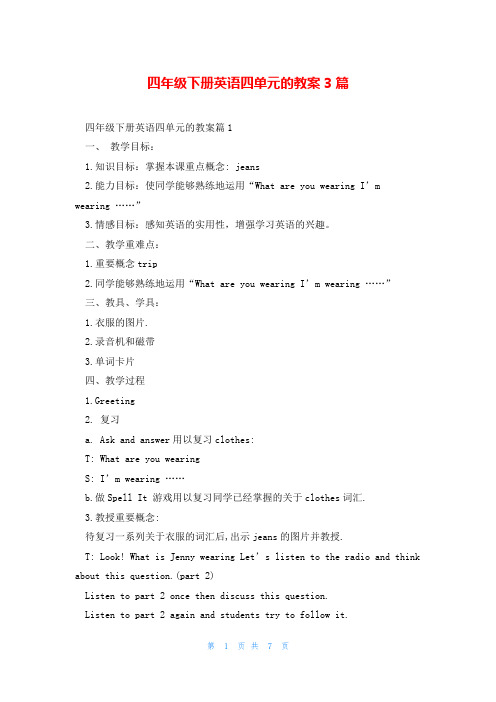
四年级下册英语四单元的教案3篇四年级下册英语四单元的教案篇1一、教学目标:1.知识目标:掌握本课重点概念: jeans2.能力目标:使同学能够熟练地运用“What are you wearing I’mwearing ……”3.情感目标:感知英语的实用性,增强学习英语的兴趣。
二、教学重难点:1.重要概念trip2.同学能够熟练地运用“What are you wearing I’m wearing ……”三、教具、学具:1.衣服的图片.2.录音机和磁带3.单词卡片四、教学过程1.Greeting2. 复习a. Ask and answer用以复习clothes:T: What are you wearingS: I’m wearing ……b.做Spell It 游戏用以复习同学已经掌握的关于clothes词汇.3.教授重要概念:待复习一系列关于衣服的词汇后,出示jeans的图片并教授.T: Look! What is Je nny wearing Let’s listen to the radio and think about this question.(part 2)Listen to part 2 once then discuss this question.Listen to part 2 again and students try to follow it.4.Practiceivide the class into small groups and ask the students to take turns describing what they are wearing to each other.they can say:This is a……I have a ……I’m wearing……5.Read after the tape.6. 完成活动手册第1题7. 作业: a. 完成活动手册剩余局部.b. 对话练习.板书设计:Lesson19: What Are You WearingWhat are you wearingI’m wearing ……jeans四年级下册英语四单元的教案篇2教学目标:1. 复习序数词,以和英语中日期的表示方法。
(完整版)新版PEP小学四年级下册英语第四单元教案
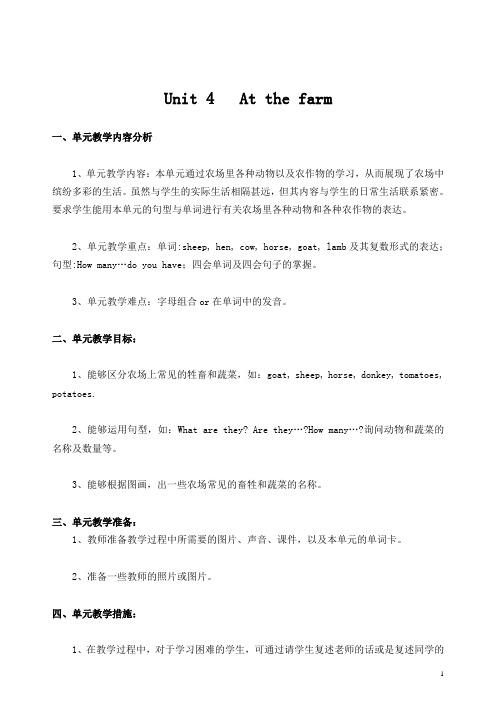
Unit 4 At the farm一、单元教学内容分析1、单元教学内容:本单元通过农场里各种动物以及农作物的学习,从而展现了农场中缤纷多彩的生活。
虽然与学生的实际生活相隔甚远,但其内容与学生的日常生活联系紧密。
要求学生能用本单元的句型与单词进行有关农场里各种动物和各种农作物的表达。
2、单元教学重点:单词:sheep, hen, cow, horse, goat, lamb及其复数形式的表达;句型:How many…do you have;四会单词及四会句子的掌握。
3、单元教学难点:字母组合or在单词中的发音。
二、单元教学目标:1、能够区分农场上常见的牲畜和蔬菜,如:goat, sheep, horse, donkey, tomatoes, potatoes.2、能够运用句型,如:What are they? Are they…?How many…?询问动物和蔬菜的名称及数量等。
3、能够根据图画,出一些农场常见的畜牲和蔬菜的名称。
三、单元教学准备:1、教师准备教学过程中所需要的图片、声音、课件,以及本单元的单词卡。
2、准备一些教师的照片或图片。
四、单元教学措施:1、在教学过程中,对于学习困难的学生,可通过请学生复述老师的话或是复述同学的回答,让学生对老师和同学的发言引起注意,让学生意识到要仔细听别人的说话。
2、对于学习还不错,但是不愿或害怕发言的学生,课堂中教师主动请他们表达其意见,培养他们良好的学习英语的习惯。
3、充分运用英语名、英文歌、儿歌、绕口令、顺口溜、谜语等,给予小学生语言感染的机会。
还可开展各种活动,鼓励学生交际。
五、单元计划用时:6课时第一课时教学目标:1、听、说、认读主要语言结构:What are these? Are these...?并能根据实际情况进行简略回答。
2、能够准确朗读对话。
教学重点:句型What are these? Are these…?及其简略回答。
教学难点:these的发音。
【PEP】四年级下英语Unit 4优质精品课教案

【PEP】四年级下英语Unit 4优质精品课教案一. 教材分析PEP教材四年级下英语Unit 4的主题是“Seasons”,主要让学生掌握季节相关的词汇和表达方式,以及进行简单的季节描述。
本单元的内容包括天气、季节、节日等,通过学习本单元,学生能够听懂、会说、会读关于季节和天气的词汇和句子,并能运用所学知识进行简单的季节描述。
二. 学情分析四年级的学生已经掌握了基本的英语语音、词汇和语法知识,具备一定的听、说、读、写能力。
但是,学生的语言表达能力、思维能力和创造力还需要进一步培养。
此外,学生对于季节和天气的概念可能还不够清晰,需要通过生活中的实例来加深理解。
三. 教学目标1.知识目标:学生能够听懂、会说、会读关于季节和天气的词汇和句子,如spring, summer, autumn, winter, sunny, cloudy, rny, windy等。
2.能力目标:学生能够运用所学知识进行简单的季节描述,提高语言表达能力和思维能力。
3.情感目标:学生能够激发对季节变化的兴趣,增强对自然环境的关注。
四. 教学重难点1.重点:季节和天气的词汇和句子。
2.难点:运用所学知识进行简单的季节描述。
五. 教学方法1.情境教学法:通过设置季节和天气的情境,让学生在实际语境中学习和运用词汇和句子。
2.互动教学法:引导学生进行小组合作、角色扮演等互动活动,提高学生的参与度和积极性。
3.任务型教学法:设计具有实际意义的小任务,让学生在完成任务的过程中运用所学知识。
六. 教学准备1.教学PPT:制作包含季节和天气相关词汇和句子的PPT,图文并茂,生动有趣。
2.卡片:准备季节和天气的词汇卡片,用于游戏和练习。
3.实物:准备与季节和天气相关的实物,如春天的花朵、夏天的太阳等,用于展示和教学。
七. 教学过程1.导入(5分钟)利用实物或图片展示季节和天气的变化,引导学生谈论自己喜欢的季节和天气,激发学生的学习兴趣。
2.呈现(10分钟)通过PPT展示本节课的主要词汇和句子,如spring, summer, autumn, winter, sunny, cloudy, rny, windy等,并用生动的语言和动作进行解释和示范。
人教PEP版四年级英语下册Unit 4单元教案
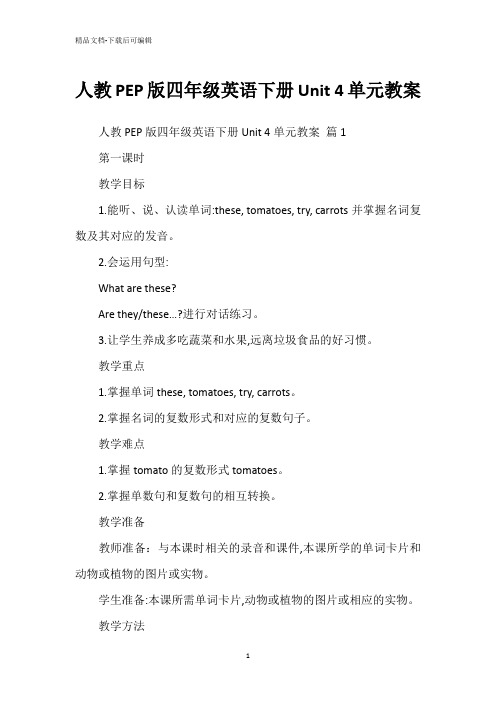
人教PEP版四年级英语下册Unit 4单元教案人教PEP版四年级英语下册Unit 4单元教案篇1第一课时教学目标1.能听、说、认读单词:these, tomatoes, try, carrots并掌握名词复数及其对应的发音。
2.会运用句型:What are these?Are they/these…?进行对话练习。
3.让学生养成多吃蔬菜和水果,远离垃圾食品的好习惯。
教学重点1.掌握单词these, tomatoes, try, carrots。
2.掌握名词的复数形式和对应的复数句子。
教学难点1.掌握tomato的复数形式tomatoes。
2.掌握单数句和复数句的相互转换。
教学准备教师准备:与本课时相关的录音和课件,本课所学的单词卡片和动物或植物的图片或实物。
学生准备:本课所需单词卡片,动物或植物的图片或相应的实物。
教学方法1.分角色表演教学法教师让同学们分角色表演Lets talk部分的对话,创设英语情景,让同学感受英语的语言氛围。
2.游戏教学法学生三人一组,进行对话:What are these?Are these apples?Are these tomatoes? Yes.在对话过程中不断增强学生的学习兴趣。
教学过程Step 1: Warm-up1.教师热情地和学生打招呼问好,做简单的Free talk。
2.播放歌曲Mary has a little lamb。
3.看图片拼读单词教师展示图片(已经学过的动物名词),说:Whats this in English?Its a/an… How do you spell it?让学生一个接一个地快速说出对应的单词及其拼写。
4.展示前三单元的单词,学生通过抢答的方式造句,教师对表现突出的同学奖励贴画。
5.Main Scene(1)学生看书36、37 页,说一说:What can you see in the picture?Where are the children?(2)找一找下列单词的意思:horses, potatoes, carrots, sheep。
PEP小学四年级英语下册第四单元教案
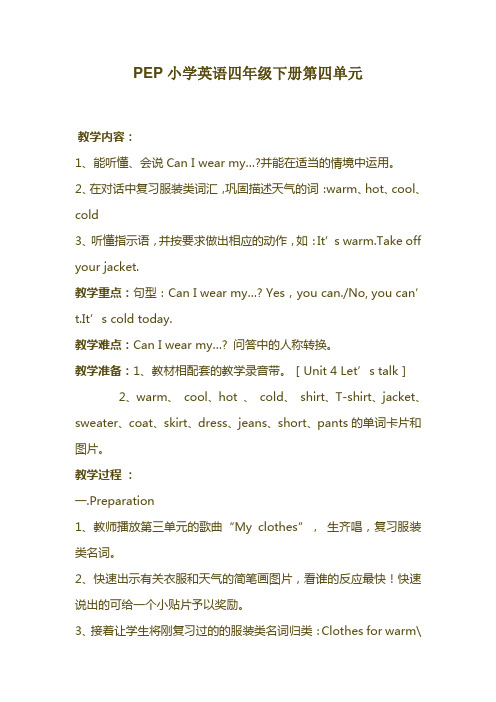
PEP小学英语四年级下册第四单元教学内容:1、能听懂、会说Can I wear my…?并能在适当的情境中运用。
2、在对话中复习服装类词汇,巩固描述天气的词:warm、hot、cool、cold3、听懂指示语,并按要求做出相应的动作,如:It’s warm.Take off your jacket.教学重点:句型:Can I wear my…? Yes,you can./No, you can’t.It’s cold today.教学难点:Can I wear my…? 问答中的人称转换。
教学准备:1、教材相配套的教学录音带。
[Unit 4 Let’s talk]2、warm、 cool、hot 、 cold、 shirt、T-shirt、jacket、sweater、coat、skirt、dress、jeans、short、pants的单词卡片和图片。
教学过程:一.Preparation1、教师播放第三单元的歌曲“My clothes”,生齐唱,复习服装类名词。
2、快速出示有关衣服和天气的简笔画图片,看谁的反应最快!快速说出的可给一个小贴片予以奖励。
3、接着让学生将刚复习过的的服装类名词归类:Clothes for warm\cool\hot \ cold days,为下面即将学习的对话进行铺垫。
4、播放课本P47的Let’s chant,第一遍听,第二遍师生共唱。
二.Presentation1.情景呈现(1)方法1:教师课件展示炎热的天气,引导学生叙述It’s hot. 再拿出刚才复习cold单词的简笔画,说:Look , It's cold today .Can I wear my new shirt?引导学生回答No, you can’t 领读并板书。
方法2:教师直接说: It’s warm today. Can I wear my sweater?(教师根据实际情况问,让学生根据实际情况回答。
Unit 4 At the farm B Let’s talk(教案)人教PEP版英语四年级下册

Unit 4 At the Farm B Let’s Talk (教案)1. 教学目标通过本节课的学习,学生能够:•能够运用所学的词汇和句型,描述动物和他们的生活环境。
•能够在日常生活和学习中积极运用学到的英语知识,提高语言运用能力。
•培养学生的合作意识和团队协作精神。
•提高学生对英语学习的兴趣,增强其热爱学生英语的情感。
2. 教材分析本节课是英语四年级下册Unit 4 At the Farm中的第二课,主要讲解了动物和它们的生活环境。
本节课的语言点有:•词汇:Farm, animals, duck, chicken, horse, sheep, cow, pig, pen, pond, field, barn, hay.•句型:What animals are on the farm? The duck quacks. The chicken clucks. The horse neighs. The sheep baa. The cow moos. The pig oinks.3. 教学准备•PPT•美工纸、颜料、剪刀、胶水、卡纸等。
•单词卡片和图片卡片。
4. 教学过程Step 1. Warm-up•Greet the students and ask them some questions to review the unit.•Elicit the following words from the students:–Farm–Animal–Duck–Chicken–Horse–Sheep–Cow–Pig–Pen–Field–Barn–HayStep 2. Presentation•Use PPT to show the pictures of different animals on the farm.•Ask the students what animals are on the farm and then elicit the sounds the animals make.Step 3. Practice•Divide the class into small groups and give each group some cards with pictures of different animals on the farm.•Have the students work in groups and show the pictures to each other while saying the sounds the animals make.•After practicing for a while, have the students switch cards and continue practicing until they have gone through all the cards.Step 4. Consolidation•Have the students complete a worksheet, filling in the blanks with the correct animal names and sounds they make.•Then, have the students present their work to the class.Step 5. Extension•Ask the students to draw pictures of the different animals on the farm and their living environment.•After the students have finished drawing, ask them to describe their pictures using the words they have learned in class.5. 教学反思在这节课中,我对教学内容进行了充分准备,通过多种方式让学生积极参与课堂活动,提高了他们的英语学习兴趣。
pep小学四年级英语下册第四单元教案

pep小学四年级英语下册第四单元教案pep小学四年级英语下册第四单元教案第四单元第一时教案题:Unit 4 It’s ar tda 第一时教学重点:句型:It’s ar / ht / ld / l in …;词汇:ld、l、ht、ar、eather教学难点:单词eather的发音。
教具准备:一张中国地图以及本时所需的单词卡片。
天气预报英解说的实录。
教材相配套的教学教材相配套的教学录音带。
学生准备好四张描述天气状况的形容词卡片以及写有城市名称的卡片若干。
教学过程:(一)热身、复习(ar-up/Revisin)1、学生一起说儿歌(Let’s hant P31)2、教师手指自己的衣服说:I a earing a … hat are u earing?引导学生说出自己穿的衣服的名称,如: a shirt、eans、bla shes…(二)呈现新(Presentatin)教师说:It’s ar tda(指指外面)S e ear shirts r T-shirts Tda e are ging t learn abut the eather N let’s ath a eather reprt教师播放一段英解说的天气预报实录。
待学生看完后,教师说:This is a eather reprt同时呈现单词卡片,领读eather reprt(把卡片贴到黑板上)教师要注意提醒学生读eather时,th咬舌尖。
教师播放Unit 4 Let’s learn A部分的。
学生观看。
教师提问:Is it a eather reprt?学生回答:es, it’s a eather reprt教师再问:Is it ar in Lhasa?点击句子It’s l in Lhasa引导学生答出:N It’s l in Lhasa让更多的学生重复回答。
告诉学生拉萨位于我国x藏自治区,那里的天气很凉快,l是形容天气凉快;而ar一词是形容天气暖和,北京的春天就是很温暖的。
【PEP】四年级下英语Unit4优质精品课教案
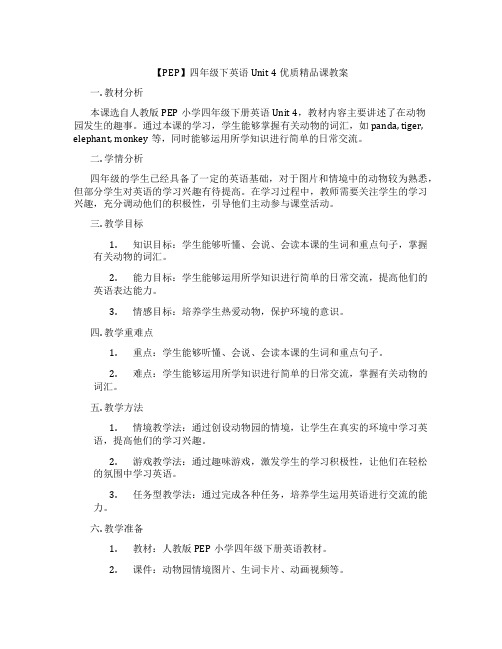
【PEP】四年级下英语Unit 4优质精品课教案一. 教材分析本课选自人教版PEP小学四年级下册英语Unit 4,教材内容主要讲述了在动物园发生的趣事。
通过本课的学习,学生能够掌握有关动物的词汇,如panda, tiger, elephant, monkey等,同时能够运用所学知识进行简单的日常交流。
二. 学情分析四年级的学生已经具备了一定的英语基础,对于图片和情境中的动物较为熟悉,但部分学生对英语的学习兴趣有待提高。
在学习过程中,教师需要关注学生的学习兴趣,充分调动他们的积极性,引导他们主动参与课堂活动。
三. 教学目标1.知识目标:学生能够听懂、会说、会读本课的生词和重点句子,掌握有关动物的词汇。
2.能力目标:学生能够运用所学知识进行简单的日常交流,提高他们的英语表达能力。
3.情感目标:培养学生热爱动物,保护环境的意识。
四. 教学重难点1.重点:学生能够听懂、会说、会读本课的生词和重点句子。
2.难点:学生能够运用所学知识进行简单的日常交流,掌握有关动物的词汇。
五. 教学方法1.情境教学法:通过创设动物园的情境,让学生在真实的环境中学习英语,提高他们的学习兴趣。
2.游戏教学法:通过趣味游戏,激发学生的学习积极性,让他们在轻松的氛围中学习英语。
3.任务型教学法:通过完成各种任务,培养学生运用英语进行交流的能力。
六. 教学准备1.教材:人教版PEP小学四年级下册英语教材。
2.课件:动物园情境图片、生词卡片、动画视频等。
3.教具:动物园动物玩偶、贴纸等。
七. 教学过程1.导入(5分钟)教师出示动物园的图片,引导学生谈论他们所熟悉的动物,为新课的学习营造轻松的氛围。
2.呈现(10分钟)教师展示本课的生词和句子,用动画或实物展示的方式,让学生直观地感知和学习。
3.操练(10分钟)教师学生进行小组活动,用所学词汇和句子进行交流,提高他们的口语表达能力。
4.巩固(10分钟)教师通过游戏、竞赛等形式,让学生运用所学知识,巩固课堂所学。
小学英语四年级下册第四单元
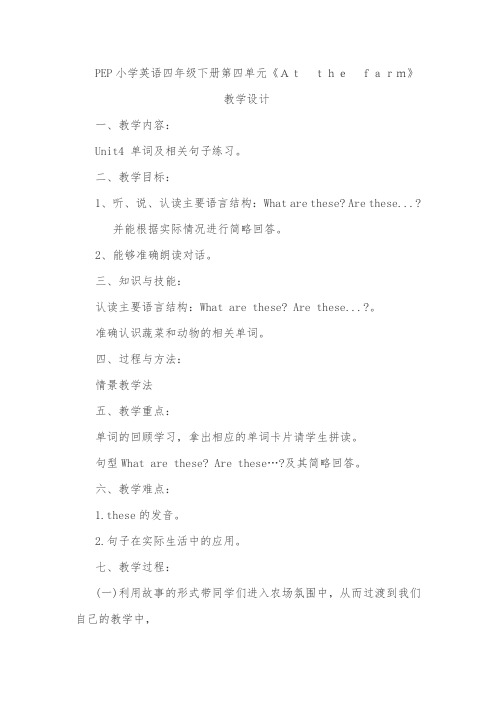
PEP小学英语四年级下册第四单元《Atthefarm》教学设计一、教学内容:Unit4 单词及相关句子练习。
二、教学目标:1、听、说、认读主要语言结构:What are these? Are these...?并能根据实际情况进行简略回答。
2、能够准确朗读对话。
三、知识与技能:认读主要语言结构:What are these? Are these...?。
准确认识蔬菜和动物的相关单词。
四、过程与方法:情景教学法五、教学重点:单词的回顾学习,拿出相应的单词卡片请学生拼读。
句型What are these? Are these…?及其简略回答。
六、教学难点:1.these的发音。
2.句子在实际生活中的应用。
七、教学过程:(一)利用故事的形式带同学们进入农场氛围中,从而过渡到我们自己的教学中,看视频,之后用单词卡片的形式回顾所学单词,导入句子,描述事物:1、教师和学生聊一聊我们的农场里有的蔬菜和动物。
(What are these ?)2、带领学生进入农场氛围,让学生为老师解决疑惑,充分调动学生积极性,引导学生用Are they…?说是什么蔬菜。
3、用让学生带领老师参观农场的方式让学生充分用自己的话进行描述。
(二)教学新课1、教师将蔬菜和动物卡片拿在手里问学生:What are these…?,并引导学生根据实际用they are ….回答。
如果学生回答对了,就进行鼓励。
教师要继续问:What are these?直到回答正确为止。
(教师在操作时应多问几名学生,以增加语言的输入量。
)教师适时板书句型框架。
(二)小组讨论给学生两副农场的图片,让他们用自己的话对图片进行描述,并用上所学句子Are these…?或What are these?先小组讨论然后进行竞赛,教师进行评价。
谈论精彩的给予奖励。
分小组做对话练习(三)巩固练习1、完成教师课件上的操练句型:What are these? Are these…?请学生作答,给予鼓励。
pep英语四年级教案下第四单元
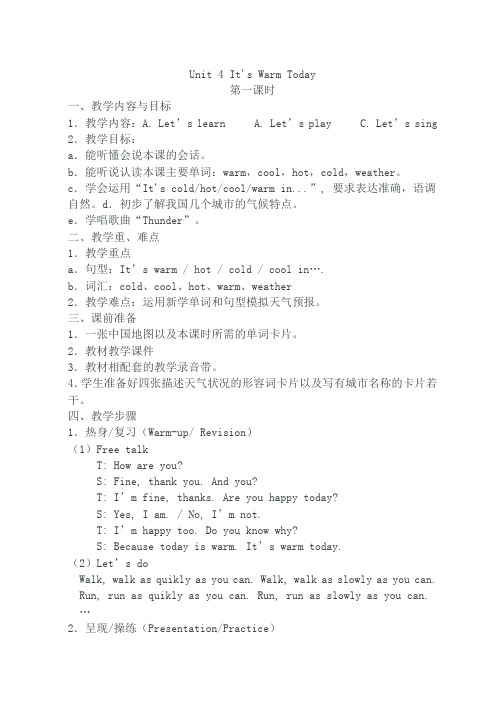
Unit 4 It's Warm Today第一课时一、教学内容与目标1.教学内容:A. Let’s learn A. Let’s play C. Let’s sing 2.教学目标:a.能听懂会说本课的会话。
b.能听说认读本课主要单词:warm,cool,hot,cold,weather。
c.学会运用“It's cold/hot/cool/warm in...”, 要求表达准确,语调自然。
d.初步了解我国几个城市的气候特点。
e.学唱歌曲“Thunder”。
二、教学重、难点1.教学重点a.句型:It’s warm / hot / cold / cool in….b.词汇:cold、cool、hot、warm、weather2.教学难点:运用新学单词和句型模拟天气预报。
三、课前准备1.一张中国地图以及本课时所需的单词卡片。
2.教材教学课件3.教材相配套的教学录音带。
4.学生准备好四张描述天气状况的形容词卡片以及写有城市名称的卡片若干。
四、教学步骤1.热身/复习(Warm-up/ Revision)(1)Free talkT: How are you?S: Fine, thank you. And you?T: I’m fine, thanks. Are you happy today?S: Yes, I am. / No, I’m not.T: I’m happy too. Do you know why?S: Because today is warm. It’s warm today.(2)Let’s doWalk, walk as quikly as you can. Walk, walk as slowly as you can. Run, run as quikly as you can. Run, run as slowly as you can.…2.呈现/操练(Presentation/Practice)(1)教学hotT: Oh, I’m very tired. Are you tired? And I’m very thirsty. Can I drink some water, please?Ss: OK!T:(教师倒开水开始喝)Oh, my goodness! It’s too hot! Please touch it, is it hot?Ss: Yes, it’s hot.学生传递这杯水并学说新词hot。
- 1、下载文档前请自行甄别文档内容的完整性,平台不提供额外的编辑、内容补充、找答案等附加服务。
- 2、"仅部分预览"的文档,不可在线预览部分如存在完整性等问题,可反馈申请退款(可完整预览的文档不适用该条件!)。
- 3、如文档侵犯您的权益,请联系客服反馈,我们会尽快为您处理(人工客服工作时间:9:00-18:30)。
Unit4 At the farm参考教案第四单元教学计划一、单元教学内容分析1、单元教学内容:本单元通过农场里各种动物以及农作物的学习,从而展现了农场中缤纷多彩的生活。
虽然与学生的实际生活相隔甚远,但其内容与学生的日常生活联系紧密。
要求学生能用本单元的句型与单词进行有关农场里各种动物和各种农作物的表达。
2、单元教学重点:单词:sheep, hen, cow, horse, goat, lamb及其复数形式的表达;句型:How many…do you have;四会单词及四会句子的掌握。
3、单元教学难点:字母组合or在单词中的发音。
二、单元教学目标:1、能够区分农场上常见的牲畜和蔬菜,如:goat, sheep, horse, donkey, tomatoes, potatoes.2、能够运用句型,如:What are they? Are they…?How many…?询问动物和蔬菜的名称及数量等。
3、能够根据图画,出一些农场常见的畜牲和蔬菜的名称。
三、单元教学准备:1、教师准备教学过程中所需要的图片、音频、ppt课件,以及本单元的单词卡。
2、准备一些教师的照片或动物图片。
3、教师提前在班班通上备好课,需要的素材资源收藏。
四、单元教学措施:1、在教学过程中,对于学习困难的学生,可通过请学生复述老师的话或是复述同学的回答,让学生对老师和同学的发言引起注意,让学生意识到要仔细听别人的说话。
2、对于学习还不错,但是不愿或害怕发言的学生,课堂中教师主动请他们表达其意见,培养他们良好的学习英语的习惯。
3、充分运用英语名、英文歌、儿歌、绕口令、顺口溜、谜语等,给予小学生语言感染的机会。
还可开展各种活动,鼓励学生交际。
五、单元教学反思:第一课时 A Let’s talk一、教学目标:1、听、说、认读主要语言结构:What are these? Are these...?并能根据实际情况进行简略回答。
2、能够准确朗读对话。
二、教具准备:教学ppt、单词卡片。
三、教学重点:句型What are these? Are these…?及其简略回答。
四、教学难点:these的发音。
五、教学过程:➢复习引题1、教师和学生聊一聊每个人喜爱的蔬菜。
(I like…Do you like…?)2、教师说谜语,引导学生用Are they…?来猜猜是什么蔬菜。
a、They are red. They look like apples, but they aren’t apples. What are they?b、They are tender and green. What are they?c、They are long and orange. Rabbits like eating them. What are they?d、They are round, pink and white. What are they?e、They are brown. French fries are made of them. What are they?学生猜对了,教师回答Yes,they are.并拿出相应的单词卡片请学生拼读;如果猜错了,教师回答No, they aren’t. 再请其他人猜, 直到猜对为止。
➢教学新课1、教师请学生将装有蔬菜卡片的盒子盖好放在桌子上,然后走到同学们中间,随意指着几个盒子问:Are these…?,并引导学生根据实际用Yes, they are. / No, they aren’t.回答。
如果学生回答的是No, they aren’t.教师要继续问:What are these?并引导学生用They are …回答。
(教师在操作时应多问几名学生,以增加语言的输入量。
)教师适时板书句型框架。
2、教师将自己带来的蔬菜卡片分别放在几个盒子里,请几个学生过来边摸边问:Are these…?或What are these?教师做出相应的回答。
3、学生两人一组运用黑板上的句型互相猜猜对方盒内的蔬菜。
4、播发Let’s talk的录音,学生听录音,后跟读、模仿。
5、分小组做对话练习。
➢巩固练习1、完成Let's play部分,操练句型:What are these? Are these…?➢布置作业1、听第38页的Let’s talk 部分的录音,读给同伴、朋友或家长听。
➢板书设计Unit4 At the farmWhat are these?They’re… .六、教学反思第二课时 A Let’s learn一、教学目标:1、能听、说、认读单词:tomato、green beans、potato、carrot以及它们的复数形式。
2、通过说唱B部分的歌谣巩固所学单词的复数形式。
二、教具准备:1、Let’s learn B部分的课件和动画、录音资源。
2、相关的单词卡片。
3、所学蔬菜的实物。
4、Let’s chant的动画和音频资源。
三、教学重点:单词:tomato、green beans、potato、carrot四、教学难点:potato和tomato的复数形式。
五、教学过程:➢复习引题➢请学生欣赏Let’s chant部分歌谣,教师要根据歌词适时举起相应的图片。
教学新课1、教师手举一个西红柿,说:I like tomatoes. Do you like tomatoes?引导学生用I like …或I don’t like…根据自己的实际情况表达。
2、教师再拿起一夹青豆,边说边完全呈现:Oh,it’s long and green. They are green beans. Do you like green beans? 让学生在回答中学习单词。
3、出示土豆:Do you know it? French fries are made of it. It’s a potato. Do you like potatoes? 学生根据用I like …或I don’t like…根据自己的实际进行情况表达。
4、请学生猜谜语:They are long and orange. Rabbits like eating them? What are they? 学习单词carrot。
5、教师将四种蔬菜分别放在教室的不同位置,然后说单词,请学生指出相应的实物。
➢巩固练习1、教师请学生看着书听歌谣。
2、让学生观察歌谣中like后的蔬菜单词和Let’s learn中的单词有什么不同。
启发学生说出like后的名词是以复数形式出现的。
教师适当强调tomato和potato 的复数形式拼写的变化,carrot的复数形式读音的变化。
➢布置作业1、读课文第39页并背诵Let's chant。
➢板书设计Unit4 At the farmtomatoes、green beans、potatoes、carrots六、教学反思第三课时 A Let’s spell一、教学目标:1、让学生掌握含有字母组合or的单词发音和认读书写。
2、能听、说、读、写horse, fork, homework, world map四个词语。
二、教具准备:教学ppt、单词卡片。
三、教学重点:能听、说、读、写horse, fork, homework, world map四个词语。
四、教学难点:正确书写horse, fork, homework, world map四个词语。
五、教学过程:➢复习引题1、师生做日常口语练习:A: What are these?B: They are...A: Are these ...?B: Yes, they are./No, they aren't.2、请学生表演A部分Let’s talk的对话。
➢教学新课1、播放Read, listen and chant的录音,让学生听歌谣。
2、让学生跟着动画学说歌谣,同时可用手打节奏。
3、播放Read, listen and number 的录音,让学生给单词排序。
4、听音后反复读四个单词,在此基础上进行描红,达到书写格式正确的目的。
➢巩固练习1、完成Look, listen and write部分的练习。
➢布置作业1、抄本课单词4+1模式➢板书设计horse, fork, homework, world mapor发/ɔː/ /ɜː/六、教学反思第四课时 B Let’s talk一、教学目标:1、能听懂“What are those? Are they...? How many...?”,并能在情景运用。
2、进一步巩固名词复数及读音规则。
3、通过小组活动的形式培养学生的合作意识。
二、教具准备:教学ppt、单词卡片。
三、教学重点:句型What are those? Are they…?How many…do you have?的理解与应用。
四、教学难点:名词复数及其读音规则。
五、教学过程:➢复习引题1、欣赏本单元歌曲。
2、提问:What can you hear in this song? 学生说出在歌中听到的动物的单词。
➢教学新课1、教师拿起几支笔握在手中,不要露出笔尖。
引导学生用Are they来猜猜是什么笔, 教师根据实际回答:Yes, they are. /No, they aren’t.2、教师随手拿起几个笔袋:Are they pencil-boxes? 学生回答:Yes, they are. 或No, they aren’t. 然后教师说:They are not pencil-boxes. They are pencil-cases.3、组织学生分组利用自己的学习用品问答A:Are they …? B:Yes, they are. /No, they aren't.(教师提供资源:desks/tables pants/short sunglasses/glasses)4、学生汇报练习情况,当学生对话后,教师要接着问:How many…do you have? 引导学生答出相应的数量。
5、打开Let’s talk部分课件,学生观看1-2遍,在情景中理解对话的语句。
6、教师就对话内容提问,检查学生的理解情况。
(显示课件的插图)Are they sheep?/ goats?/ horses?/ donkeys?/hens?/ cows? How many …?7、跟录音朗读对话,注意模仿语音语调。
8、小组分角色表演对话,教师巡视指导。
➢巩固练习1、启发学生替换有关动物单词,创新对话。
A:Are they …?B:Yes,they are./ No, they aren’t.(They are .…)A:How many … do you have?B:I have .…➢布置作业1、向同伴、朋友或家长了解更多的关于农场上的动物的知识。
